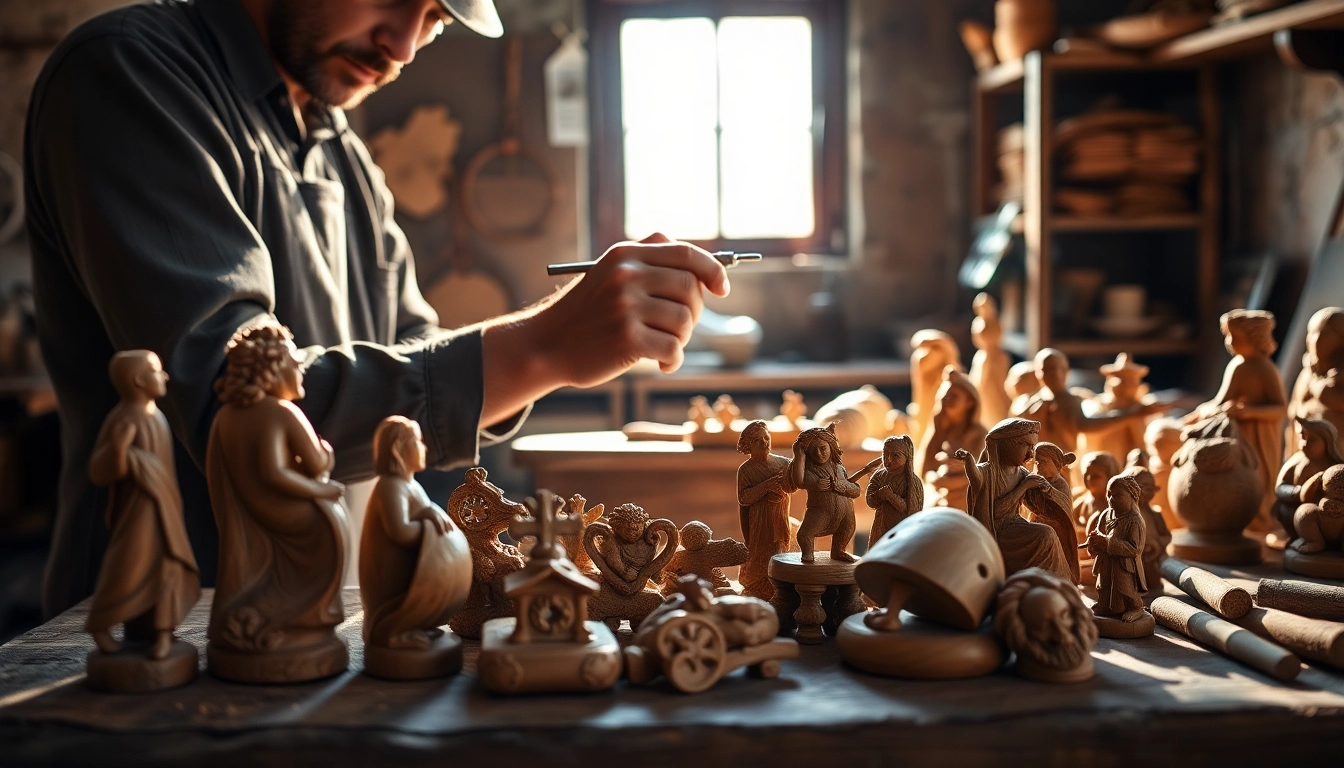Introduction to Olive Wood Carvings
Olive wood carvings have been a cherished art form for centuries, deeply intertwined with the cultural and spiritual life of the regions they originate from, particularly the Mediterranean and the Holy Land. These exquisite pieces of art, crafted from the wood of the ancient olive tree, embody both natural beauty and rich cultural significance. The artisans of Palestine, especially those from Bethlehem and Jerusalem, have developed intricate skills over generations, creating works that are not only visually stunning but also steeped in meaning. For those looking to explore the beauty and craftsmanship inherent in these pieces, olive wood carvings provide a glimpse into the artistry and spirituality of their makers.
What Are Olive Wood Carvings?
Olive wood carvings are artistic, handcrafted items made from the wood of the olive tree. This tree is not only vital for the production of olives but also has a deep cultural significance, particularly in Mediterranean cultures. The wood is prized for its rich colors, unique grain patterns, and density, which together create stunning and lasting works of art.
Artisans use various carving techniques to create a wide range of items, from religious artifacts like crosses and nativity scenes to decorative figures and kitchenware. Each piece carries a story, and the craftsmanship often reflects the artistic traditions that have been passed down through generations.
The Cultural Significance of Olive Wood Art
In regions like Palestine and Israel, olive wood carvings hold profound cultural and spiritual significance. The olive tree is often seen as a symbol of peace, endurance, and resilience; it has been a part of the local landscape for thousands of years. The act of carving olive wood is not merely about producing an object but is also an exercise in preserving history and culture.
For many artisans, this craft provides a means of livelihood and a way to express their heritage. The stories and traditions of their ancestors are embedded in each piece, making these works not only items for sale but also vessels of history and identity.
Types of Olive Wood Carvings and Their Uses
Olive wood carvings come in many forms and serve a variety of purposes:
- Religious Artifacts: Items such as crosses, statues of saints, and nativity scenes are particularly popular among Christians. These carvings are often used in homes, churches, and as gifts during religious celebrations.
- Decorative Items: Many artisans create stunning decorative pieces, including bowls, coasters, and figurines, which add a touch of elegance to home decor.
- Kitchenware: Functional items, such as cutting boards, utensils, and serving bowls, showcase the versatility of olive wood while being practical for everyday use.
Each type of carving demonstrates the skill of the artisan and the unique characteristics of the olive wood itself, offering buyers a range of options that enrich their lives with cultural relevance.
How Olive Wood Carvings are Made
The Process of Carving Olive Wood
The journey of an olive wood carving begins with the selection of properly aged wood from the olive tree. The wood used for carving is sourced from pruned branches and trees that are no longer fruit-bearing, ensuring that the resources are used sustainably and respectfully.
The actual carving process involves several steps:
- Preparation: The wood is cut to size and shaped according to the planned design. Artisans typically work with hand tools, allowing for a high degree of detail and precision.
- Carving: Using chisels and knives, the artisan carefully sculpts the wood into the desired form. This requires not only skill but also an intimate understanding of the wood’s properties, as different areas may require different techniques.
- Finishing: The carved piece is then sanded to achieve a smooth texture, and often treated with natural oils to enhance the grain and provide protection.
This meticulous process reflects the dedication and expertise of the artisan, culminating in a work of art that embodies both beauty and cultural significance.
Tools and Techniques Used in Olive Wood Carvings
The tools used in olive wood carving vary from traditional hand tools to modern equipment. Commonly employed tools include:
- Chisels and Gouges: Essential for shaping and detailing the wood.
- Knives: Used for intricate work and fine details.
- Sanders: For achieving a smooth finish on the carved pieces.
While modern tools can improve efficiency, many artisans prefer traditional methods, as they believe these tools offer more control and connection to the craft. Techniques often involve a combination of relief carving, inlay work, and stacking, enabling artisans to produce unique and complex designs that tell a story.
Artisan Skill Development in Wood Carving
Becoming a skilled artisan in olive wood carving involves years of practice and mentoring. Many artisans learn the craft through familial traditions, receiving guidance from experienced carvers in their communities. Apprenticeships allow younger craftsmen to hone their skills under the watchful eyes of masters, ensuring the transmission of techniques that have been passed down for generations.
As artisans develop their skills, they often specialize in specific styles or types of carvings, further enriching the diversity of products available in the market. This emphasis on craft and legacy helps ensure the longevity of olive wood carving as a vital cultural practice.
Choosing Quality Olive Wood Carvings
Identifying Authenticity in Olive Wood Products
When purchasing olive wood carvings, it is essential to ensure that the products are authentic. Look for the following indicators of quality:
- Grain Patterns: Authentic pieces should display distinct and beautiful grain patterns characteristic of olive wood, often with a rich, warm color.
- Workmanship: High-quality carvings will show attention to detail, with smooth edges and no visible tool marks.
- Source Origin: Buying from reputable sellers who openly disclose their sources can help authenticate the piece’s origin and assure buyers of its cultural significance.
As the market for olive wood products grows, so does the prevalence of imitations. By being aware of these indicators, buyers can make informed purchases and support genuine artisans.
Factors Affecting the Quality of Olive Wood Carvings
Several factors contribute to the overall quality of olive wood carvings:
- Wood Quality: The age and growing conditions of olive trees greatly affect the wood’s density, grain, and color. Well-aged, sustainably sourced wood typically yields the best results.
- Artisan Skill: The level of experience and artistic flair of the craftsman impacts the intricacy and detail of the final product.
- Finishing Techniques: The type of treatment applied after carving can enhance the wood’s appearance and longevity. Natural oils are preferred for a warm, inviting glow.
Understanding these factors can help buyers appreciate the craftsmanship and labor behind each piece.
Price Ranges and What to Expect
Prices for olive wood carvings can vary significantly depending on size, complexity, and the artisan’s reputation. Factors influencing cost include:
- Size: Larger pieces typically command higher prices due to the amount of wood and labor involved.
- Complexity: Intricate designs requiring more time and skill will cost more than simpler carvings.
- Market Demand: Seasonal fluctuations, especially around holidays, can impact pricing.
On average, small decorative items might range from $20-$50, while larger, complex sculptures can start from $200 and rise to several thousand dollars. It’s essential for buyers to set a budget while considering the artistry and craftsmanship involved.
Decorating with Olive Wood Carvings
Incorporating Olive Wood Art in Home Decor
Olive wood carvings are not only beautiful but can also enhance the overall aesthetic of a space. Here are a few suggestions for incorporating these pieces into home decor:
- Centerpieces: Use carved bowls or sculptures as stunning centerpieces on dining tables or coffee tables.
- Wall Art: Hang intricate wall carvings or assemblages to create unique focal points in a room.
- Shelves: Decorate bookshelves with a mix of olive wood figurines and books for a harmonious look.
These natural, warm-toned pieces can complement a wide variety of design styles, from rustic to contemporary.
Perfect Gift Ideas Featuring Olive Wood Carvings
Due to their cultural significance and unique artistry, olive wood carvings make for exceptional gifts. Consider these ideas:
- Wedding Gifts: Customized carvings can symbolize love and union, making them perfect for newlyweds.
- Religious Occasions: Crosses and nativity sets are meaningful gifts for baptisms, confirmations, or Christmas.
- Homewarming Gifts: Decorative bowls, coasters, and kitchenware add a warm, personal touch to new homes.
Presenting a gift that embodies a rich cultural heritage adds a thoughtful element that recipients will treasure for years.
Creating Themed Displays with Olive Wood Art
Using olive wood carvings in themed displays can enhance the visual narrative in a space. Here are some ideas:
- Faith Display: Combine crosses, religious figurines, and candles to create a serene spiritual corner.
- Nature Theme: Pair olive wood sculptures with plant elements to create a cohesive natural aesthetic.
- Seasonal Displays: Use olive wood pieces in seasonal decor, integrating them into festivities like Christmas or Easter.
These displays not only tell a story but also invite conversation and reflection among guests.
Where to Buy Olive Wood Carvings
Top Online Retailers for Olive Wood Products
Purchasing olive wood carvings has become more accessible with various online retailers specializing in these unique products. Some recommended platforms include:
- Holy Land Gift Shop – Offers a wide selection of handcrafted olive wood carvings.
- Bethlehem Handicrafts – Features exquisite religious items and decor.
- Handmade Palestine – Showcases a range of handcrafted pieces by local artisans.
These platforms not only offer quality products but also ensure that your purchases support local artists and communities.
Supporting Local Artisans in Bethlehem and Jerusalem
When buying olive wood carvings, choosing to purchase directly from local artisans is one of the best ways to support the traditional craft. Markets in Bethlehem and Jerusalem are filled with artisans eager to share their stories and creations. Shopping locally not only helps sustain their community but also allows buyers to own unique, handmade pieces that carry personal significance.
Understanding Shipping and Sourcing Ethics
As the demand for olive wood carvings increases, understanding the sourcing and shipping ethics becomes crucial. Ensure your chosen retailer prioritizes fair trade practices and sustainable sourcing. This approach supports the preservation of olive wood carving traditions and protects the environment. Consider the following:
- Transparency: Seek retailers who are open about their sourcing methods.
- Fair Trade Practices: Ensure artisans receive fair compensation for their work.
- Environmental Responsibility: Check whether sourcing methods prioritize sustainability and conservation.
By choosing ethical options, you enhance the positive impact of your purchase while celebrating the rich heritage of olive wood artistry.



